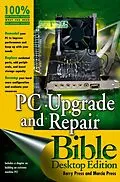* Updated and revised with eighty percent new material, this bookis 100 percent of what readers need to upgrade, fix, ortroubleshoot PCs* Sixty-five percent of U.S. households own a PC; this bookcaters to the do-it-yourselfers in these households, both novicesand tech hobbyists alike, who are looking for an approachablereference* A one-stop reference for topics such as video, CD, and DVD;multimedia; storage; communications (network and Internet);peripherals; and integrating with laptops and handhelds* Concludes with a step-by-step tutorial on building an "extreme"machine that can handle the most demanding multimedia or gamingapplications* Written by Marcia and Barry Press, authors of PC Toys(076454229X)
Autorentext
Barry Press has designed leading-edge computer hardware, software, and networks for over 30 years, including a unique cable television modem, campuswide ATM networks, a desktop computer capable of analyzing adverse drug interactions, and an artificial intelligence planning system. He has programmed Windows since Version 1.0 and has taught as an adjunct professor of computer science at the University of Southern California.
Marcia Press worked in public accounting as a tax CPA for what was then one of the Big Eight, moving later to her own practice. She handles the administrative part of the work for the Presses’ computer books — the tracking, calls, follow-ups, and research — and does the sanity checks on their initial drafts. She’s a fan of good wine, gardening, reading, and shopping, and is a serious gourmet cook.
The Presses are the authors of PC Upgrade and Repair Bible; Networking by Example; Teach Yourself PCs; and PC Toys: 14 Cool Projects for Home, Office, and Entertainment and coauthors of Building the Power-Efficient PC: A Developer’s Guide to ACPI Power Management.
Klappentext
If PC experts can do it, you can do it too...
Today’s PCs with the new generation of Windows® are terrific tools. But like all tools, they require maintenance and sometimes need fixing. This convenient reference makes it easy to keep your PC in top condition. It covers everything from choosing a computer and monitor to upgrading hardware, adding peripherals, networking the PCs in your home, preventing and diagnosing problems, and even boosting PC performance.
Inside, you’ll find what you need to know about repairing and upgrading your PC
- Decide whether it’s practical to upgrade existing equipment
- Find out what you need to bring an underpowered machine up to speed
- Reconfigure your PC to achieve specific results
- Choose the right machine when replacing an old PC
- Custom-build a system that precisely meets your needs
- Install upgrades in an existing computer and fine-tune your system
- Integrate your PCs into a local area network and the Internet
- Beef up performance and take your PC to the next level
What’s a Desktop Bible?
Wiley Desktop Edition Bibles are power-packed, streamlined versions of the standard Bibles. They include everything you need to know for practical application and are concisely written and conveniently designed for day-to-day use.
Zusammenfassung
- Updated and revised with eighty percent new material, this book is 100 percent of what readers need to upgrade, fix, or troubleshoot PCs
- Sixty-five percent of U.S. households own a PC; this book caters to the do-it-yourselfers in these households, both novices and tech hobbyists alike, who are looking for an approachable reference
- A one-stop reference for topics such as video, CD, and DVD; multimedia; storage; communications (network and Internet); peripherals; and integrating with laptops and handhelds
- Concludes with a step-by-step tutorial on building an "extreme" machine that can handle the most demanding multimedia or gaming applications
- Written by Marcia and Barry Press, authors of PC Toys (076454229X)
Inhalt
Preface.
Acknowledgments.
Part I: Introduction.
Chapter 1: Getting Ready.
Chapter 2: Why Isn’t the Same Computer Right for Everyone?
Chapter 3: PC Overview.
Part II: Processors and Motherboards.
Chapter 4: Processors, Cache, and Memory.
Chapter 5: Buses, Chipsets, and Motherboards.
Part III: Video.
Chapter 6: Video.
Chapter 7: Monitors and Flat Panels.
Part IV: Storage.
Chapter 8: Hard Disks and Disk Arrays.
Chapter 9: CD and DVD.
Chapter 10: Removable Storage.
Part V: Networks and Communications.
Chapter 11: Modems.
Chapter 12: Wired and Wireless Networking.
Chapter 13: Hubs, Switches, Routers, and Firewalls.
Chapter 14: Configuring a Windows Network.
Chapter 15: Internet Services, Antivirus, and Anti-Spam.
Part VI: Multimedia and Peripherals.
Chapter 16: Sound Cards, Speakers, Microphones, and MP3 Players.
Chapter 17: Digital Cameras, Video Capture, and DVDs.
Chapter 18: Keyboards and Game Controllers.
Chapter 19: Mice, Trackballs, and Tablets.
Chapter 20: Printers, Scanners, and All-in-One Units.
Part VII: Integration.
Chapter 21: Cases, Cooling, and Power.
Chapter 22: Laptops and Handheld Computers.
Chapter 23: You’re Going to Put That Where?
Chapter 24: Diagnosis and Repair.
Chapter 25: Building an Extreme Machine.
Glossary.
Index.
